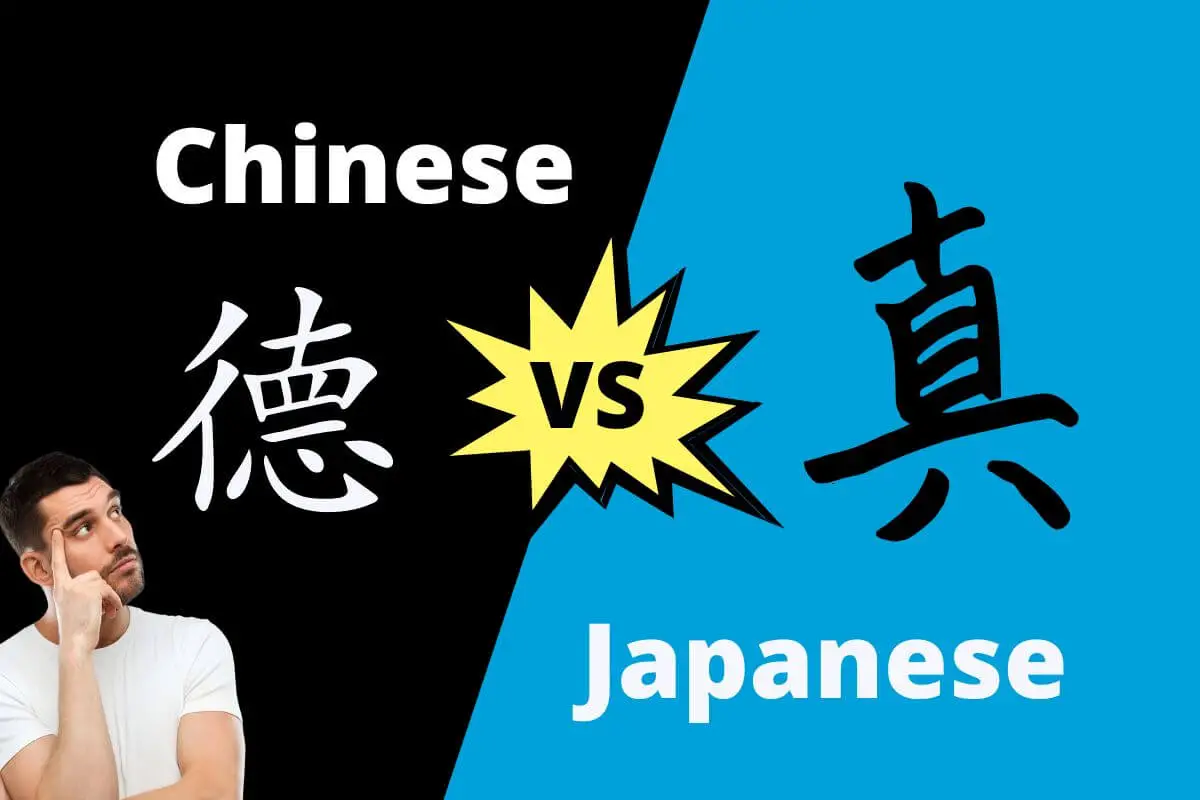The main difference between Chinese and Japanese is that Chinese is an SVO language (subject, verb, object), and Japanese is an SOV language (subject, object, verb.)
Maybe you’re wondering about the Chinese and Japanese languages, their writing styles, pronunciation, and more. Though the two languages share some similarities, each has gradually evolved over the years, making them unique.
Apart from this, many other differences between Chinese and Japanese languages exist.
Table of Contents
Chinese vs. Japanese – Comparison Table
The following tables compare the two languages in tabular format.
| Chinese | vs. | Japanese |
| Simpler grammar system. This is because it lacks prepositions, verb conjugations, and tense changes. |
Grammar | Japanese has possibly the most complex grammar globally |
| Chinese pronunciation is somewhat difficult. | Pronunciation | Pronunciation is the simplest part of Japanese. |
What is Chinese?
The Chinese language originated from 6,000-year-old dynasties and is the oldest written language in the world.
Basic History
Chinese characters were inscribed on turtle shells dating back to the Shang Dynasty 1. The Chinese written language uses single symbols and characters to represent each word of its vocabulary.
Majorly written Chinese characters have roots in the spoken language with particular meanings.
A Chinese dictionary generally contains 40,000 characters. In order to read a newspaper, you must be able to understand at least 2,000 to 3,000.

How the Language has Changed
Languages tend to evolve, and this is true for the Chinese language, which has changed over time. However, the principles of the language, characters, and symbols have remained the same.
Even though spoken Chinese languages have many regional dialects, written language is the standard form of communication.
The key difference between different dialects is pronunciation and vocabulary.
Chinese Writing Systems
The Chinese language is very different from the English language. It doesn’t have an alphabet. Instead, the langage has 3,000 common Chinese characters and symbols.
In Chinese, each character has one or more than one meaning. The combination of characters makes different words.
Pictographic Characters
Chinese characters have evolved from images, so they’re called pictographic.
Types of Written Characters
The written form is categorized into four types.
- Simplified
- Traditional
- Informal slang
- Phonetic
Traditional vs. Simplified Characters
Regions like Macau, Hong Kong, and Taiwan use classic characters. However, Mainland China uses simplified ones. The key difference between traditional and simplified is that they are written differently but have similar pronunciations.
What is Japanese?
Japanese is a unique Asian language that consists of an ideogram and a phonogram. It’s Japan’s national language and is spoken by more than 124 million people, the 6th largest speaking population in the world.
Basic History
The Japanese language can be traced back to its history almost 2,000 years ago. The original language of Japan was called Yamato Kotoba.
How the Language has Changed
However, the contemporary Japanese language is majorly influenced by the Chinese language in terms of writing system, pronunciation, and vocabulary.
Based on the characters of the Chinese language, the Japanese have created the Kanji characters.
The phonology of Japanese grammar has a strong personality of an open syllable language that ends with a vowel. The Japanese language has the word order of “subject-modifier-predicate.”

Japanese Writing Systems
The Japanese language earlier didn’t have any written format, but it developed with time.
It was the 5th century when the Chinese writing system was first introduced to Japan. The contemporary Japanese language is a fusion of 3 different letter systems: Kanji and two syllabic scripts: Katakana and Hiragana.
Hiragana is more commonly used in writing text than Katakana. Katakana is mainly used for loanwords and advertising phrases.
Difference Between Chinese and Japanese
Grammar
The Chinese language has a simple grammar system. It doesn’t have prepositions, verb conjugations, or tense changes.
However, Japanese grammar is possibly the most complex globally.
Pronunciation
Chinese characters have no rules to follow other than remembering their pronunciation. The Chinese language is challenging in terms of pronunciation.
The Japanese language has only five vowels and 14 consonants forming Japanese syllables. The Japanese language is more straightforward in terms of pronunciation.
Tone
Chinese is a tonal language, and the meanings of words constantly vary according to their tones. The Japanese language is simpler, consisting of vowels, consonants, and syllables of the same length.
Number of Writing Systems
The Japanese language has three writing systems – Hiragana, Katakana, and Kanji. In contrast, the Chinese language only has one written system ingrained in their Hanzi.
Number of Speakers
The Chinese language is spoken by 850 million, while the Japanese language is spoken by about 125 million speakers, primarily in Japan.
Where is Each Spoken?
Chinese
- Mainland China
- Singapore
- Macau
- Hong Kong
- Taiwan
- Tibet
Japanese
- Japan
- United States
- Brazil
- South Korea
- Taiwan
If you’ve enjoyed this post, check out our blog comparing pho and ramen.

